Supermicro AS-E301-9D-8CN4 Performance
For this exercise, we are using our legacy Linux-Bench scripts which help us see cross-platform “least common denominator” results we have been using for years as well as several results from our updated Linux-Bench2 scripts. At this point, our benchmarking sessions take days to run and we are generating well over a thousand data points. We are also running workloads for software companies that want to see how their software works on the latest hardware. As a result, this is a small sample of the data we are collecting and can share publicly. Our position is always that we are happy to provide some free data but we also have services to let companies run their own workloads in our lab, such as with our DemoEval service. What we do provide is an extremely controlled environment where we know every step is exactly the same and each run is done in a real-world data center, not a test bench.
We are going to show off a few results, and highlight a number of interesting data points in this article.
Python Linux 4.4.2 Kernel Compile Benchmark
This is one of the most requested benchmarks for STH over the past few years. The task was simple, we have a standard configuration file, the Linux 4.4.2 kernel from kernel.org, and make the standard auto-generated configuration utilizing every thread in the system. We are expressing results in terms of compiles per hour to make the results easier to read:
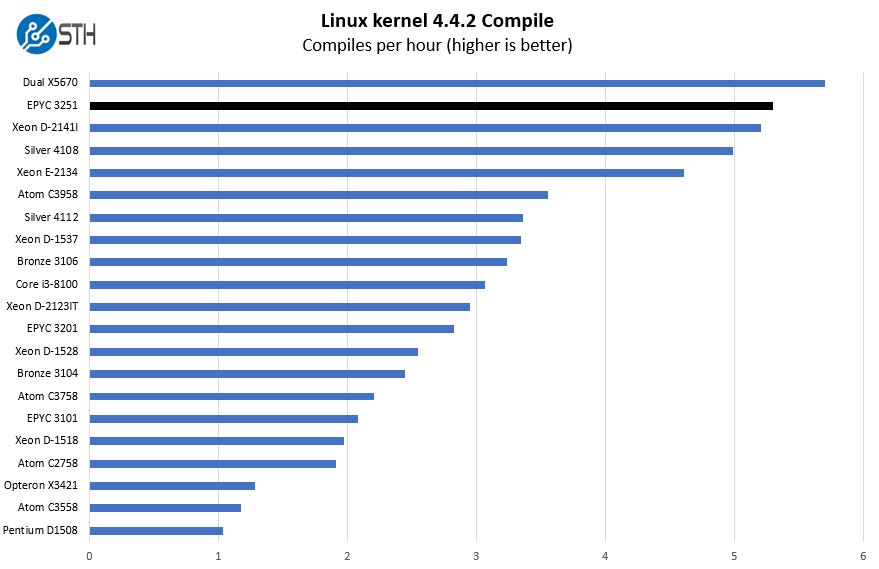
Performance of the Supermicro AS-E301-9D-8CN4 ‘s embedded AMD EPYC 3251 tops our charts of embedded parts up to eight cores here. High clock speeds along with sixteen threads mean performance is great. It comes close to the dual Intel Xeon X5670 configurations which shows just how much performance has moved into the low power embedded realm.
c-ray 1.1 Performance
We have been using c-ray for our performance testing for years now. It is a ray tracing benchmark that is extremely popular to show differences in processors under multi-threaded workloads. We are going to use our 4K results which work well at this end of the performance spectrum.
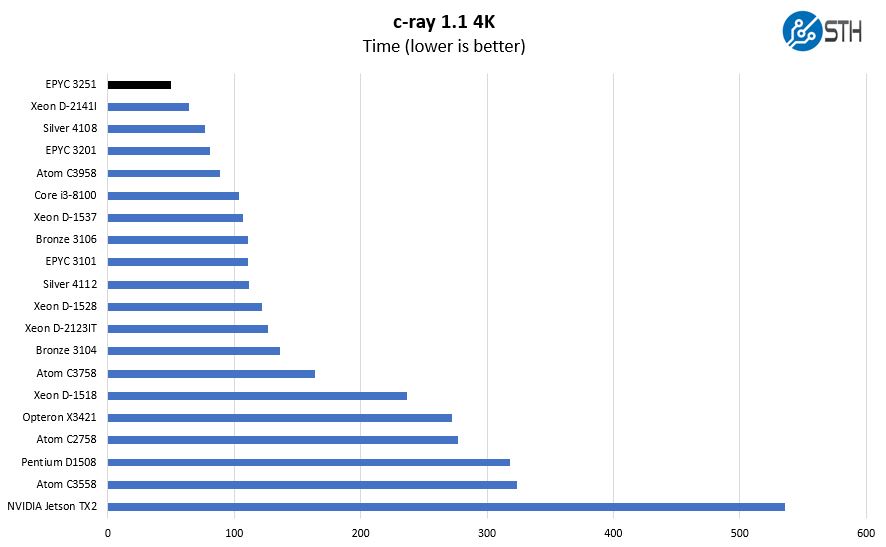
Here the AMD “Zen” architecture performs very well benefiting the Supermicro AS-E301-9D-8CN4. Clock speeds combined with high core counts and fast caches mean that AMD solutions do well here.
7-zip Compression Performance
7-zip is a widely used compression/ decompression program that works cross-platform. We started using the program during our early days with Windows testing. It is now part of Linux-Bench.
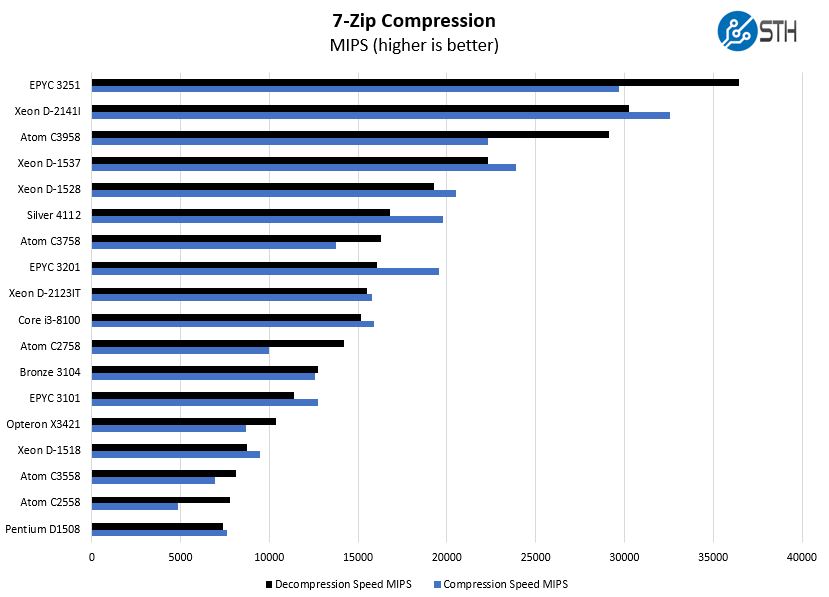
One can notice Supermicro AS-E301-9D-8CN4 with the AMD EPYC 3251 is faster than the Intel Xeon D-2141I. Supermicro offers Intel Xeon D-2141I options as well. Since the Xeon D-2141I is a higher cost and power consumption part, this can be a good alternative platform.
OpenSSL Performance
OpenSSL is widely used to secure communications between servers. This is an important protocol in many server stacks. We first look at our sign tests:
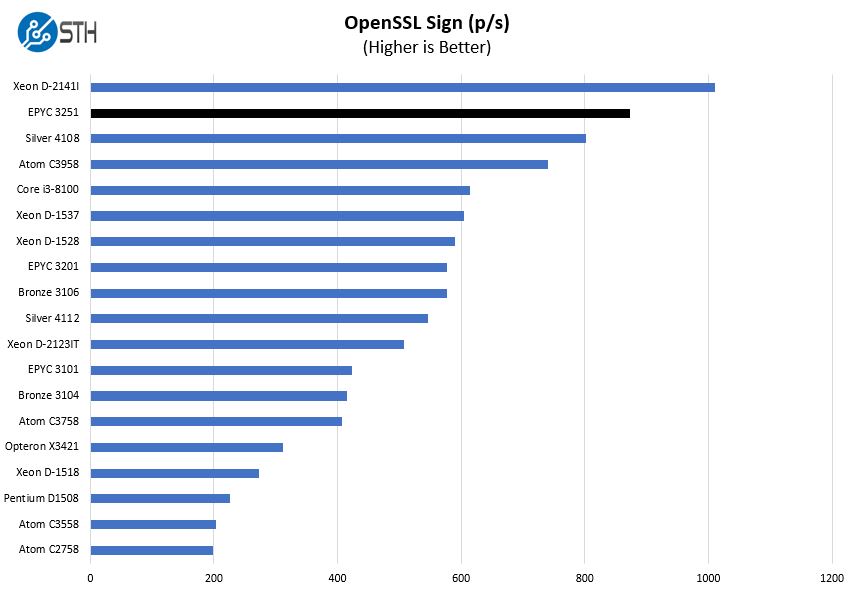
Here are the verify results:
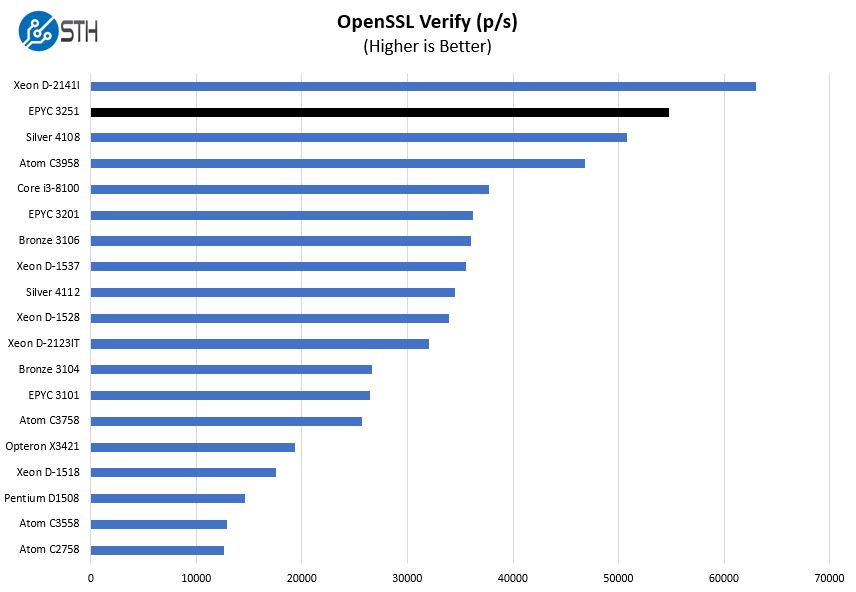
This is very interesting. Here we see the Supermicro AS-E301-9D-8CN4 offers more performance than the Intel Xeon Silver 4108 based servers. That is impressive. Our Intel Xeon Silver 4208 review was published before this review but tested after. The performance edge has moved back to the mainstream Xeons which have more PCIe lanes and I/O, as well as more memory channels. Still, the fact that AMD is competitive here says a lot about today’s market.
UnixBench Dhrystone 2 and Whetstone Benchmarks
Some of the longest-running tests at STH are the venerable UnixBench 5.1.3 Dhrystone 2 and Whetstone results. They are certainly aging, however, we constantly get requests for them, and many angry notes when we leave them out. UnixBench is widely used so we are including it in this data set. Here are the Dhrystone 2 results:
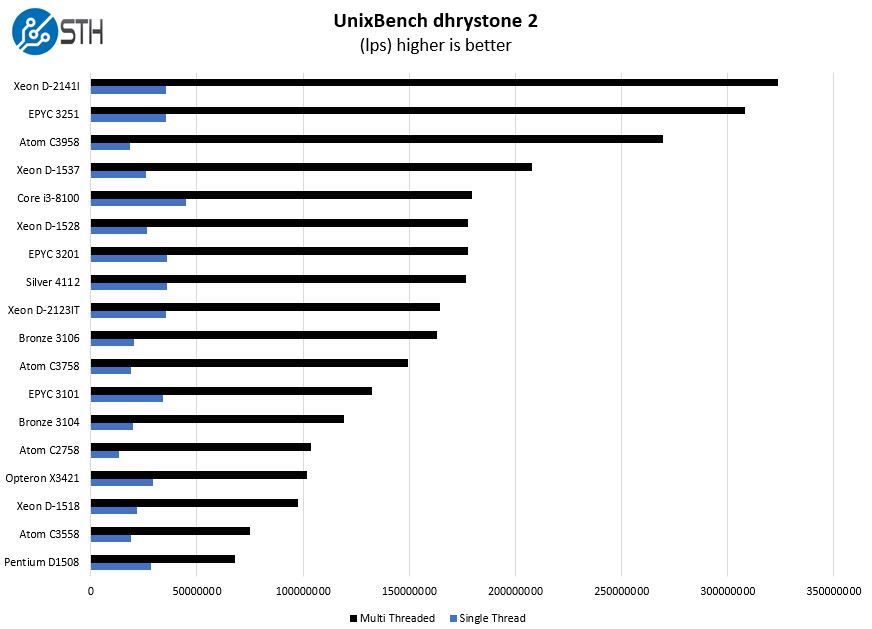
Here are the whetstone results:
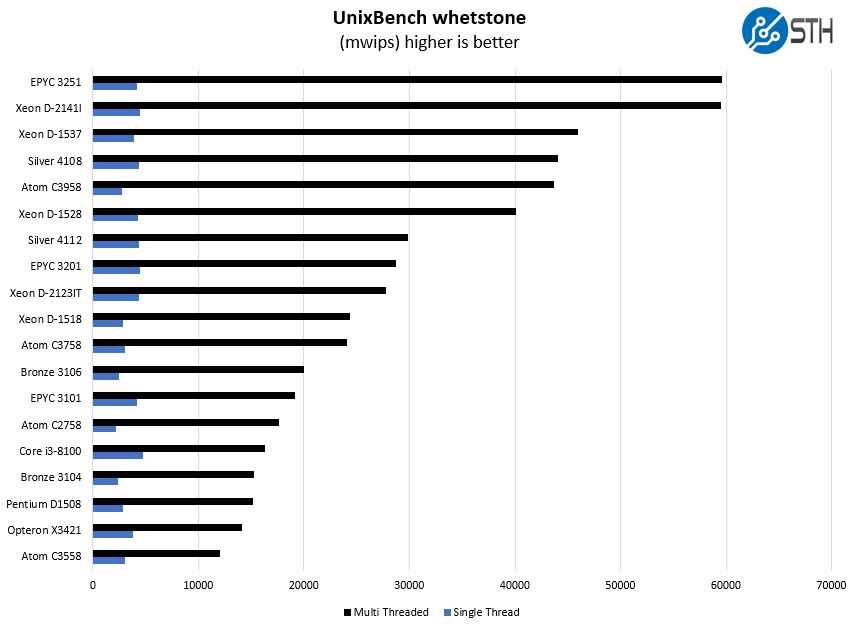
Here again, we see the Supermicro AS-E301-9D-8CN4 and the onboard AMD EPYC 3251 perform well both in single and multi-threaded tests. That is a testament to how well AMD designed the EPYC 3000 line.
Chess Benchmarking
Chess is an interesting use case since it has almost unlimited complexity. Over the years, we have received a number of requests to bring back chess benchmarking. We have been profiling systems and are ready to start sharing results:
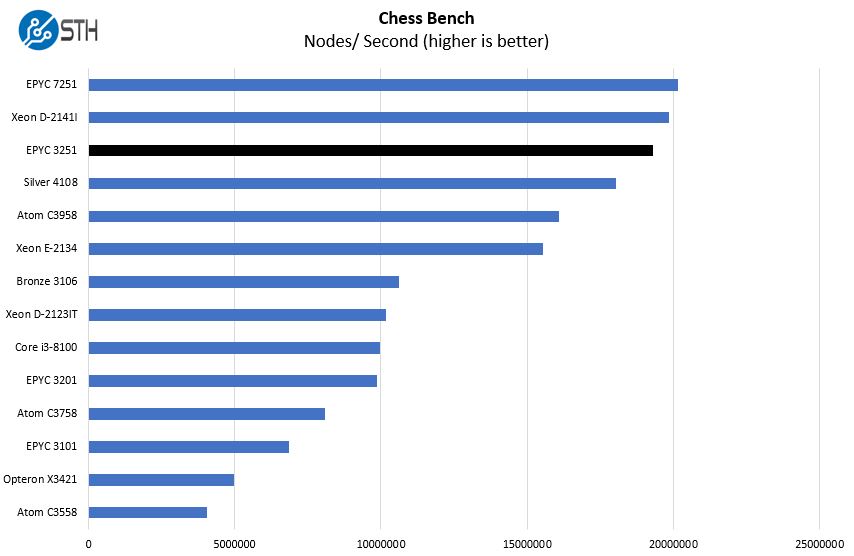
Here the Intel Xeon D-2141I again edges out the AMD EPYC 3251, but AMD is again very close at lower cost and power consumption. For the Supermicro AS-E301-9D-8CN4 that is a great trend.
Next, we are going to look at the Supermicro AS-E301-9D-8CN4 power consumption before getting to the STH Server Spider and our final words.




On every hardware metric it is rather limited: but it has fairly fast CPU cores for it’s power budget.
Like it’s brethren it is very cute and it looks nice sitting on a bench but I have a difficult time understanding why it exists. What am I supposed to use it for?
@emerth industrial applications where you need some compute on the edge such as factories/oil/chemical. From my perspective this is direct competition for the like of HPE Edgeline 1000 type of applications but at a lower cost.
The 40mm fans I don’t quite understand, at 1.5U height it’s ~66mm high so 50mm or even 60mm fans would have been possible. It could also have used the additional height for a top down 80mm or 120mm cooler for low noise applications (and a custom shroud for airflow).
I’m not OP. But this is madness
https://www.reddit.com/r/homelab/comments/c5ssva/a_very_tiny_lab
I ordered one of these from Newegg.
It DOES NOT come with:
1. PCI-E 90 degree riser card
2. ANY hard drive cages – and I have yet to figure out the part number for those
It only comes with one SAS power cable, so you can’t actually hookup 4 drives – only 2… And the cable used isn’t available on Supermicro’s store…
What a MESS.
What a MESS!
Jason, we mentioned in our review that we had a pre-production unit with some parts labeled as optional. I think this is great feedback and will send it to the team. I agree it would be good either to have this as everything in the box or an additional SKU with all of the accessories. Maybe even a note on the product page for optional components like in some other Supermicro servers.
Do you know if it’s works with ESXi 6.7? I know it’s not officially supported yet, but it would be nice to know for homelab purposes.
@Marcelo, yes it working well with ESXI 6.7.
Anyone know where can get the PCI e Riser?
Hello,
I have been looking for a mini homelab server for a while, and I don’t have a choice between the sys-e200 8d, e300 8d / e301 8d?
which would be best for an sccm lab, networking and securty?
Like Jason, I also ordered one of these from Newegg. Mine also DID NOT come with:
1. PCI-E 90 degree riser card
2. ANY hard drive cages
I reached out to SuperMicro support, and got the following part numbers for these:
1. PCI-E Riser card: RSC-RR1U-E16
2. Dual 2.5” drive bay: MCP-220-30101-0N
I will say that so far this server has been fantastic as a light virtualization host.
Thanks Mark. I read this article before your comment and also had communication with Supermicro about it. Part numbers for the cables are:
Thin SATA cable: CBL-0483L
Power cable. Although I don’t know what this is. A y-cable or whatever: CBL-PWEX-0983
It runs much more quiet than i expected. It sits in the next room, just 3m away and i can barely hear it when the door is open. Power usage is only 32W, idling with an AOC-S40G-I2Q 40G card and two SATA SSDs.
One more note: If you’re looking a for a power efficient server for your homelab, don’t be fooled by the TDP value. I own two of these and an E300-D8, which I wanted to try hoping with the lower TDP of 35W (vs. 55W of the Epyc 3251) it would consume less power when idling. The E300-D8 idles at about 36W without PCIe card and with two SATA SSDs
Supermicro seems unwilling or unable to supply the drive cages. I need six. Got one from a shop, ordered another 3, which got cancelled, because of availability. Another official supplier is taking more than two months and says they don’t know why it’s taking so long. On top the product team Supermicro promised to update the product page to list the optional parts two months ago, but didn’t even after reminding them about it. It seems this box doesn’t get any love from them.
I have the same issue no cage only 2 fans supplied & a single Sata Cable to hookup. I am thinking of engineering my own HDD cage. I can do with 2 fans